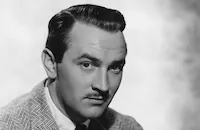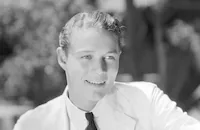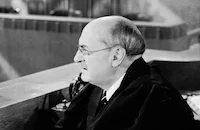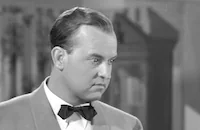A Man to Remember

Brief Synopsis
Cast & Crew
Garson Kanin
Anne Shirley
Edward Ellis
Lee Bowman
William Henry
John Wray
Photos & Videos
Film Details
Technical Specs

Synopsis
During the elaborate, public funeral of Doctor "Doc" John Abbott, inside the office of attorney Clyde Perkins, three of his respected neighbors in the small Midwestern town of Westport--banker George Sykes, newspaperman Jode Harkness and store owner Homer Ramsey--open Doc's strong box, in which they hope to find money long owed to them. As they sort through the various receipts and bills in the box, Doc's career in Westport is remembered by the group: On 16 Jun 1919, a broke and widowed Doc returns to his home town with his young son Dick. Although a seventeen-year medical veteran, Doc has difficulty borrowing money from Sykes and is forced to assume his practice on the poor side of town. Soon after opening his practice, Doc is called to deliver a baby, whose mother dies during childbirth. Devastated by his wife's death, the baby's embittered father, Tom Johnson, refuses to care for his newborn and leaves her on Doc's doorstep. Many years later, the girl, whom Doc has named Jean, lives happily with Dick and her foster father, who in spite of his own debts, accepts food and animals as payment from his poor but grateful patients. After Dick graduates from college, Doc appeals to the county Board of Supervisors, which is headed by Sykes, Harkness and Ramsey, for money to build a county hospital. Unimpressed by Doc's arguments about the importance of a public health program, the board rejects his request. Later, however, the now grown Jean is shot accidentally by Sykes's irresponsible, inebriated son Howard, and on the promise that he will not report Howard to the police, Doc pressures Sykes into building the hospital. Although Doc is responsible for the needed institution, he quietly allows Homer to receive the public adulation, then is barred from working there by a calculated regulation stipulating that only doctors who have had graduate study within the last twenty years may register as physicians. Three years later, Dick returns to Westport with a degree in neurology from a prestigious French institution. To Doc's disappointment, Dick, who admits that he enjoys money for money's sake, chooses to become partners with Dr. Robinson, Doc's more prosperous competitor. When Dick then announces that he is considering a job offer in New York, his seemingly callous attitude toward his father infuriates Jean, who worries about Doc's weak heart. One night, Doc is visited by a regenerated Johnson, whom he introduces to Jean. After Jean, who is merely polite to Johnson, goes to bed, he thanks Doc for caring for the girl and gives him $3,000 as payment. Doc then applies for admission to the same Parisian school that Dick attended. While waiting for his reply, Doc treats four children who are exhibiting symptoms of infantile paralysis. To avoid a possible polio epidemic, Doc tries to have a county fair postponed but is ridiculed as an alarmist by Sykes, Ramsey and Harkness. Determined to alert the community, Doc, at his own expense, distributes warning notices throughout the town and advises people to come in for throat spray injections. His actions outrage the county medical association, who in spite of Dick's impassioned defense of Doc, vote to suspend him. Immediately after the vote, however, a late-arriving board member informs the association that dozens of polio cases have been reported in his town. Soon cases of polio spread throughout the county, except Westport, where the disease was confined to Doc's original four cases. Although rejected by the French school, Doc is elected president of the association by acclamation and is honored by the entire town, who gather outside his house and declare him a hero. Dick, who has fallen mutually in love with Jean, then tells his father that he wants to stay in Westport and be his partner. Content at last, Doc dies quietly of a heart attack just after Jean and Dick leave to attend a patient. As Doc's funeral procession concludes, a remorseful Sykes, Ramsey and Harkness collect their debt money from Doc's strong box and conclude that the old country doctor was indeed a fine man.

Director

Garson Kanin
Cast

Anne Shirley

Edward Ellis

Lee Bowman

William Henry

John Wray

Granville Bates
Harlan Briggs
Frank M. Thomas

Dickie Jones
Carole Leete

Gilbert Emery
Joseph De Stefani

Charles Halton
Dick Elliott

Byron Foulger
Julius Tannen
Frank Jaquet

Grady Sutton
Barlowe Borland
Crew
John L. Cass
Albert D'agostino
Jack Hively
J. Roy Hunt
Millard Kaufman
Lee Marcus
Argyle Nelson
Van Nest Polglase
Renié
Robert Sisk
Douglas Travers
Roy Webb

Photo Collections
(Pressbook images courtesy of the Academy of Motion Picture Arts and Sciences)
Film Details
Technical Specs

Articles
A Man to Remember
A Man to Remember has not been seen since its original theatrical release in 1938. It was not part of the television package involving the other five "lost" RKO films that allowed them to be seen on television during the late 1950s. The only surviving copy of this film was a 35mm original nitrate, Dutch-subtitled, English-language print, which was preserved by the Netherlands Filmmuseum in 2000. The film was released in The Netherlands under the title De Plattelands Dokter (The Country Doctor, which had been its original working title in English).
The Dalton Trumbo script is told in flashbacks from the funeral of a small-town general practitioner, Dr. Abbott (Edward Ellis). Beginning in the World War I era, he selflessly tends the citizens of his town of Westport for decades, often accepting partial payments or sacks of potatoes and other goods in exchange for services. With precious little appreciation, he sacrifices career advancement and his own well-being for the welfare of his patients, fighting a deadly polio epidemic, adopting the baby of a mother who dies in childbirth and helping the town get a hospital. Meanwhile his son (Lee Bowman) is inspired to follow in his father's footsteps. In his final days, Dr. Abbott is at last recognized as a humanitarian and a genuine American hero.
The structure of Trumbo's script -- episodic flashbacks from the central character's funeral -- was his own creation and not used in the original screenplay for One Man's Journey. While this may not have been the first time such a device was used in cinema, it is significant in that it anticipates by three years the structure of Orson Welles' hugely influential Citizen Kane (1941), filmed at the same studio.
This is one of those rare remakes generally considered superior to the original. Although considered a "B" movie by its studio and shot, according to Kanin, in 15 days on a budget of only $84,000, A Man to Remember received extraordinary critical praise. The New York Times named it as one of the years ten best films. The newspaper's critic Frank S. Nugent (later to become a noted screenwriter) called it "a distinguished and unusual film, for the qualities which distinguish it are merely such elements as simplicity, honesty dignity and human warmth -- elements which properly should be found in every film drama, yet so rarely are."
A Man to Remember marked Kanin's debut as a film director; among his other directorial credits were They Knew What They Wanted (1940), My Favorite Wife (1940) and Bachelor Mother (1939). With wife Ruth Gordon, Kanin was Oscar®-nominated for the original screenplays of A Double Life (1947), Adam's Rib (1949) and Pat and Mike (1952).
Trumbo began writing scripts for various Hollywood studios in 1936 and was Oscar®-nominated for Kitty Foyle (1940). In 1947, as one of the "Hollywood Ten," he was sentenced to a jail term for refusing to testify before the House Un-American Activities Commission. Although blacklisted by the film industry, he continued to write scripts under "fronts," winning Oscar®s under other names for his screenplays for Roman Holiday (1953) and The Brave One (1957). Beginning with Spartacus (1960) Trumbo at last was again able to write under his own name.
Ellis, a performer since his childhood, was a character actor who enjoyed plum parts in such films as I Am a Fugitive from a Chain Gang (1932), Winterset and Fury (both 1936). His claim to fame was playing the title role -- the man whose disappearance William Powell is investigating, not Powell himself -- in MGM's The Thin Man (1934). Ellis' rare star turn in A Man to Remember, was described by Nugent as "splendid." Also garnering praise were Granville Bates, Harlan Briggs, Frank M. Thomas and Anne Shirley, who received star billing for her role as the adopted baby grown up.
"A Man to Remember had gone out and garnered some fantastic reviews," Kanin said in an interview. "They pulled it back and looked at it at the studio -- they had never seen it - and booked it into the enormous Rivoli Theater in New York - astonishing!"
Producers: Lee S. Marcus (Executive Producer), Robert Sisk
Director: Garson Kanin
Screenplay: Dalton Trumbo, from screenplay by Lester Cohen, Arthur Kober, Samuel Ornitz, and story by Katharine Haviland-Taylor
Cinematography: J. Roy Hunt
Film Editing: Jack Hively
Original Music: Roy Webb
Art Direction: Van Nest Polglase
Costume Design: Renié
Cast: Edward Ellis (John Abbott), Anne Shirley (Jean), Lee Bowman (Dick Abbott), William Henry (Howard Sykes), Granville Bates (George Sykes), Harlan Briggs (Homer Ramsey), Frank M. Thomas (Jode Harkness), Charles Halton (Perkins), John Wray (Johnson), Dickie Jones (Dick Abbott as a child).
BW-78m. Closed captioning.
by Roger Fristoe

A Man to Remember
Quotes
Trivia
Notes
[Editor's note: A Man to Rememberwas not viewed prior to the publication of its entry in theAFI Catalog of Feature Films, 1931-40.This entry was revised after a 2007 viewing of the film.] The working title of A Man to Remember was Country Doctor. Most of the film's action takes place in a series of flashbacks related while "George Sykes," "Homer Ramsey" and "Jode Harkness" are sitting in the office of attorney "Clyde Perkins." Each flashback begins with a close-up shot of a bill or promissory note found among the papers of "Dr. John Abbott."
A Man to Remember was broadcast on the Turner Classic Movies (TCM) cable station in April 2007, the first time it had been shown in almost seventy years. The print viewed was from a Dutch archive, in English, but with Dutch subtitles. The credits above were taken from a cutting continuity deposited in U.S. copyright records. The picture was one of six RKO films for which the rights had reverted to former RKO producer Merian C. Cooper. For additional information on the restoration and rights issues, please consult the entry above for the 1933 RKO film Double Harness.
A Man to Remember marked the first film of noted writer-director Garson Kanin(1912-1999). Modern sources state that A Man to Remember was made in fifteen days for $118,000. Katharine Haviland-Taylor's story was first made by RKO in 1933 as One Man's Journey .














